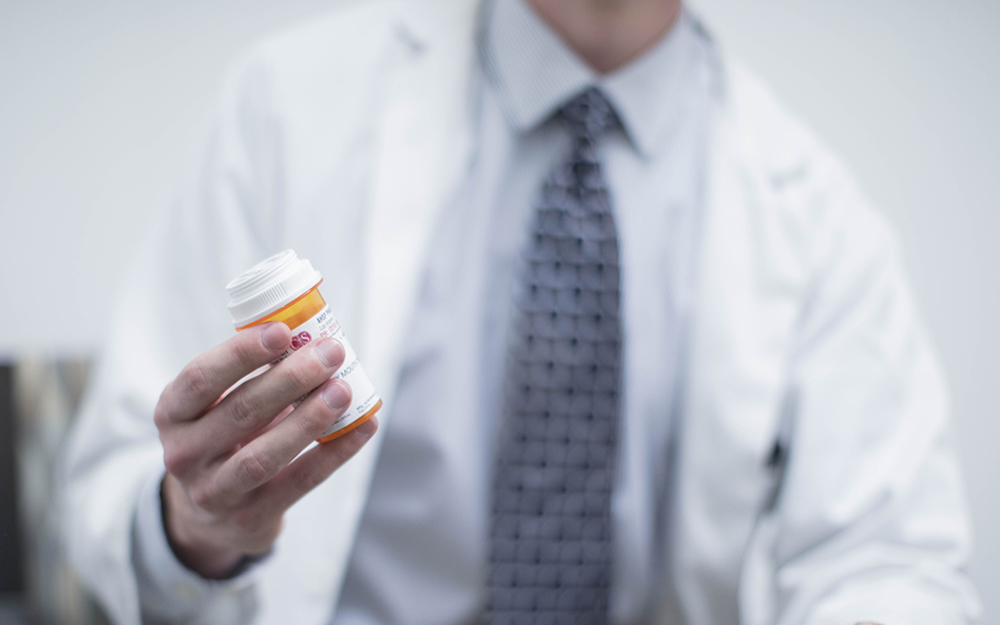Cedars-Sinai Blog
Breakthroughs in Treatment Dosing Increase Access to Life-Changing Medication for Acromegaly Patients
Feb 19, 2021 Cedars-Sinai Staff

Patients with acromegaly experience social isolation and are dependent on very costly medications to control this rare disorder. Thanks to new research at Cedars-Sinai, patients can be offered a lower-cost treatment regimen with the same excellent results as current standard of care approaches.
Existing acromegaly treatment options cost-prohibitive for patients

Vivien S. Herman-Bonert, MD
Acromegaly is a rare hormonal disorder that results from the overproduction of human growth hormone by a benign tumor of the pituitary gland, resulting in several painful, disfiguring symptoms—most notably enlarged hands, feet and facial features. Approximately 20,000 patients are diagnosed with acromegaly each year in the U.S. Appropriate control of acromegaly is crucial to prevent joint pain, high blood sugar levels, fatigue, sexual dysfunction and other poor health outcomes associated with the disease, as well as to improve patients' overall quality of life.
For many patients with acromegaly, medications are the primary treatment strategy to control the disease. Because of the disease's rarity, medications that effectively treat acromegaly are costly. Vivien Bonert, MD, clinical director of the Pituitary Center at Cedars-Sinai, sees firsthand how detrimental the high cost can be to acromegaly therapeutic outcomes.
"The average monthly cost for injectable somatostatin analogs ranges from $1,500–$2,500/month for a low dose to as much as $7,000/month, on average, for higher doses," says Bonert. "Somatostatin analogs, however, are approved by most insurances. It is more challenging to gain approval for another medication, pegvisomant, which is frequently denied due to cost."
When it is approved, pegvisomant costs patients at least $200 per day when taken daily, as is currently recommended by the Food and Drug Administration. "It's extremely expensive for patients who take pegvisomant seven days a week," adds Bonert.
Cedars-Sinai study reveals effective treatment at a lower cost
New research at the Cedars-Sinai Pituitary Center demonstrates that smaller doses of pegvisomant in combination with low-dose, long-acting somatostatin analog medications are equally effective at treating acromegaly as existing higher-dose treatment regimens—and also comes at significantly lower costs to patients.
"The very high cost of therapy for acromegaly and frequent denial of effective treatments by insurance are barriers to attaining disease control in many patients," says Bonert, the study's senior and corresponding author. "This led to my research on whether therapies could be combined using lower doses, thus maximizing benefits and minimizing the risks of each. The aim of this study was to cut down the cost to make the treatment available to more people."
The goal of the research, published in the Journal of Clinical Endocrinology & Metabolism, was to determine whether more cost-effective pairings of long-acting somatostatin analog medications and less-frequent doses of pegvisomant could normalize levels of insulin growth factor (IGF-1). Because IGF-1 stimulates the growth of bones and other tissues, efficacy of treatment is measured by its stability.
The study looked at three lower-dose drug combinations:
- Arm A—high-dose somatostatin analogs with once-a-week pegvisomant at 15 mg with a potential dose hike up to 40 mg
- Arm B—low-dose somatostatin analogs with once-a-week pegvisomant at 15 mg with a potential dose hike up to 40 mg
- Arm C—low-dose somatostatin analogs with daily pegvisomant starting at 15 mg/day and going up to 60 mg/day
To ensure the broad generalization of any findings, the research team removed response bias by randomizing patients to the different arms based on whether they were "good," "moderate" or "poor" responders to pretrial doses of somatostatin analogs.
In the end, the dual aim to reduce cost and maintain treatment efficacy was achieved. All arms of the study were shown to be less expensive than typical treatment courses with all achieving normalized ranges of IGF-1.
Arm B, a low dose of somatostatin analogs with a weekly dose of 15-40 mg of pegvisomant, was shown to be the least expensive course of treatment (just under $10,000/month). In addition, just a minority of patients required uptitration of pegvisomant.
Findings increase access to effective treatment
Acromegaly can be a debilitating and isolating disease. Because of this important research conducted by Bonert and the Cedars-Sinai team, cost can start to become less of a factor and more patients will be able to pursue treatment options that will help them achieve optimal living.
Bonert and her team are excited at the implications of the findings.
"The study shows that patients receiving high doses of this medication is mostly a waste of time and money. It is a point in favor of lower doses of pegvisomant, since even on the lowest possible doses, many patients maintained desired levels of IGF-1."

